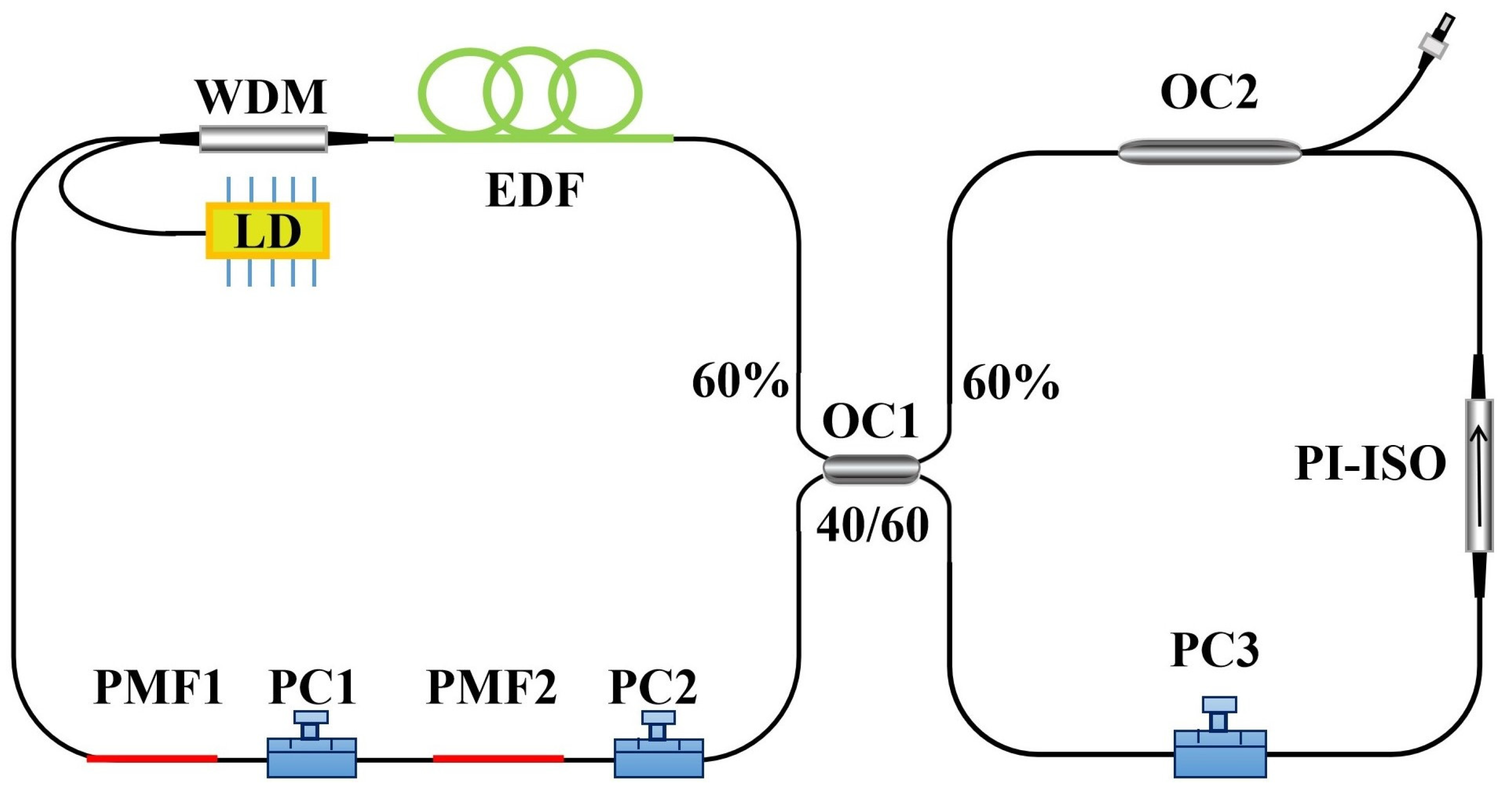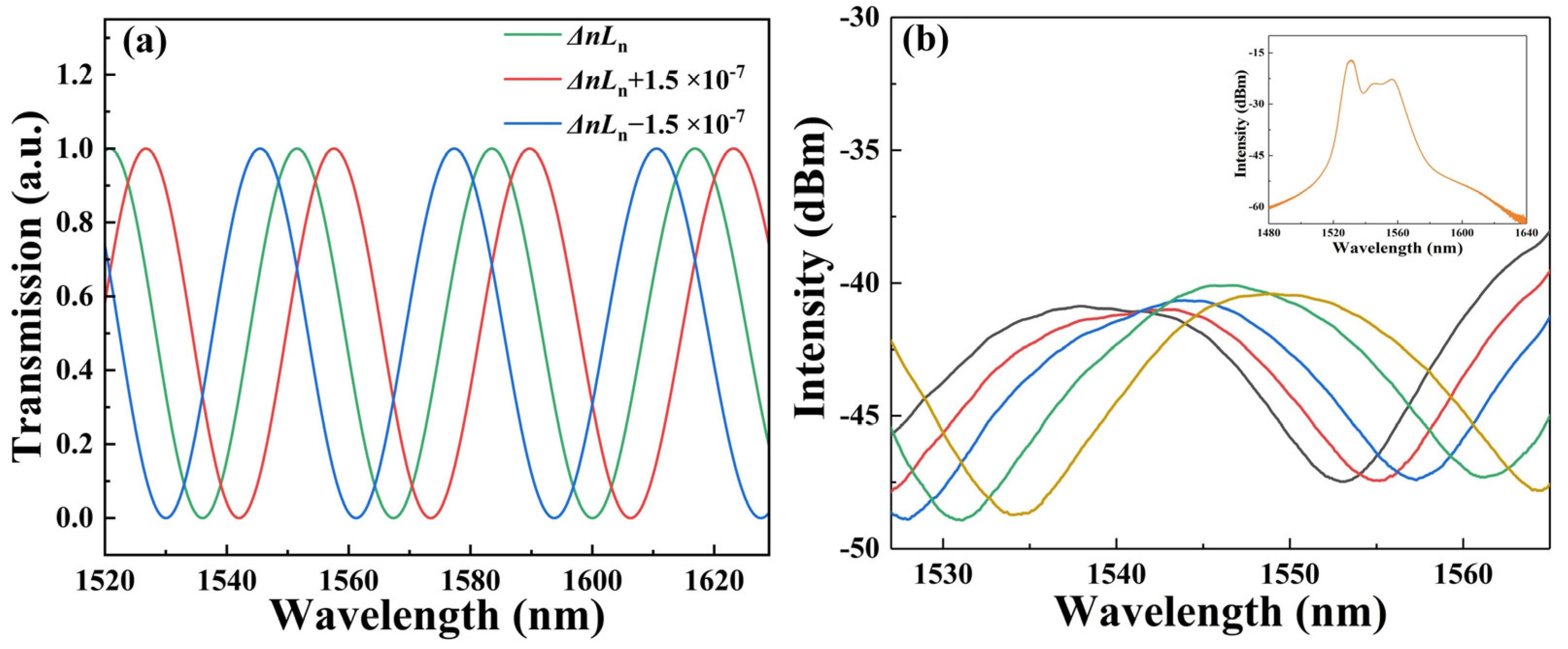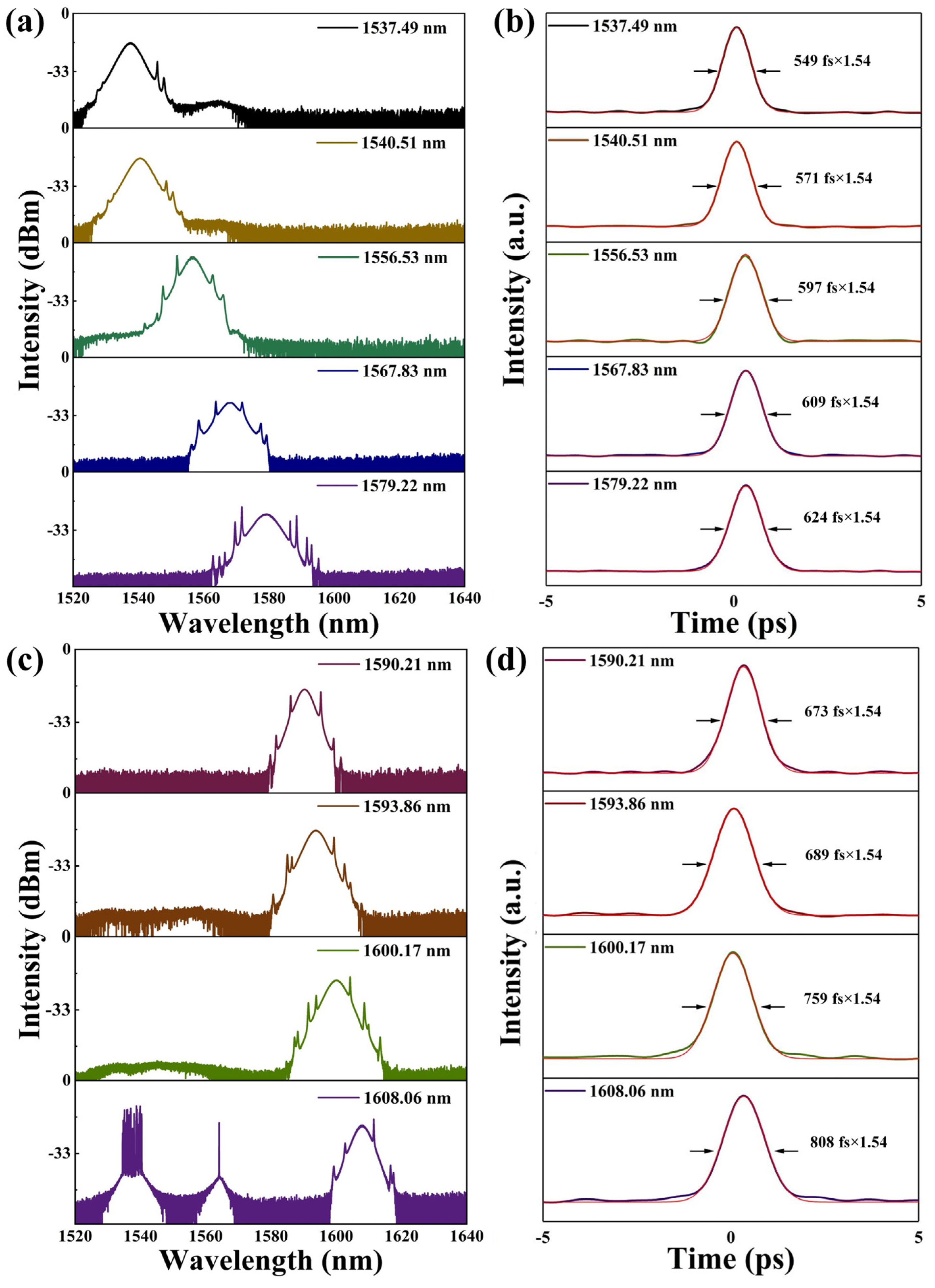C- and L-Bands Wavelength-Tunable Mode-Locked Fiber Laser
Abstract
:1. Introduction
2. Experimental Setup and Principle
2.1. Experimental Setup
2.2. Experimental Principle
3. Experimental Results and Discussion
4. Conclusions
Author Contributions
Funding
Institutional Review Board Statement
Informed Consent Statement
Data Availability Statement
Acknowledgments
Conflicts of Interest
References
- Matsuura, M.; Raz, O.; Gomez-Agis, F.; Calabretta, N.; Dorren, H.J.S. Ultrahigh-speed and widely tunable wavelength conversion based on cross-gain modulation in a quantum-dot semiconductor optical amplifier. Opt. Express 2011, 19, B551–B559. [Google Scholar] [CrossRef] [PubMed]
- Yusoff, N.M.; Abas, A.F.; Hitam, S.; Mahdi, M.A. Dual-stage l-band erbium-doped fiber amplifier with distributed pumping from single pump laser. Opt. Commun. 2012, 285, 1383–1386. [Google Scholar] [CrossRef]
- Zulkifli, M.Z.; Hassan, N.A.; Awang, N.A.; Ghani, Z.A.; Harun, S.W.; Ahmad, H. Multi-wavelength fiber laser in the s-band region using a sagnac loop mirror as a comb generator in an SOA gain medium. Laser Phys. Lett. 2010, 7, 673–676. [Google Scholar] [CrossRef]
- Obaid, H.M.; Shahid, H. Gain flattened c-band hybrid optical amplifier achieving high and flat gain over 32-nm bandwidth for dense wavelength division multiplexed system. Opt. Eng. 2019, 58, 066108. [Google Scholar] [CrossRef]
- Marshall, J.; Stewart, G.; Whitenett, G. Design of a tunable L-band multi-wavelength laser system for application to gas spectroscopy. Meas. Sci. Technol. 2006, 17, 1023. [Google Scholar] [CrossRef]
- Morin, F.; Druon, F.; Hanna, M.; Georges, P. Microjoule femtosecond fiber laser at 1.6 μm for corneal surgery applications. Opt. Lett. 2009, 34, 1991–1993. [Google Scholar] [CrossRef] [PubMed]
- Chen, N.K.; Lin, J.W.; Liu, F.Z.; Liaw, S.K. Wavelength-tunable er-doped fs mode-locked fiber laser using short-pass edge filters. IEEE Photonics Technol. Lett. 2010, 22, 700. [Google Scholar] [CrossRef]
- Hao, X.; Tong, Z.; Zhang, W.; Cao, Y. A fiber laser temperature sensor based on smf core-offset structure. Opt. Commun. 2015, 335, 78–81. [Google Scholar] [CrossRef]
- Qi, Y.H.; Kang, Z.X.; Sun, J.; Ma, L.; Jin, W.X.; Lian, Y.D.; Jian, S.S. Wavelength-switchable fiber laser based on few-mode fiber filter with core-offset structure. Opt. Laser Technol. 2016, 81, 26–32. [Google Scholar] [CrossRef]
- Huang, S.; Wang, Y.; Yan, P.; Zhao, J.; Lin, R. Tunable and switchable multi-wavelength dissipative soliton generation in a graphene oxide mode locked Yb-doped fiber laser. Opt. Express 2014, 22, 11417. [Google Scholar] [CrossRef]
- Armas-Rivera, I.; Rodriguez-Morales, L.A.; Durán-Sánchez, M.; Avazpour, M.; Carrascosa, A.; Silvestre, E.; Kuzin, E.A.; Andrés, M.V.; Ibarra-Escamilla, B. Wide wavelength-tunable passive mode-locked Erbium-doped fiber laser with a SESAM. Opt. Laser Technol. 2021, 134, 106593. [Google Scholar] [CrossRef]
- Ma, Z.L.; Long, J.G.; Lin, W.; Hong, W.; Cui, H.; Luo, Z.-C.; Xu, W.-C.; Likhachev, M.E.; Aleshkina, S.S.; Mashinsky, V.M. Tunable spatiotemporal mode-locked fiber laser at 1.55 µm. Opt. Express 2021, 29, 9465–9473. [Google Scholar] [CrossRef] [PubMed]
- Bao, Q.L.; Zhang, H.; Ni, Z.H.; Wang, Y.; Polavarapu, L.; Shen, Z.X.; Xu, Q.H.; Tang, D.Y.; Loh, K.P. Monolayer graphene as a saturable absorber in a mode-locked laser. Nano Res. 2011, 4, 297–307. [Google Scholar] [CrossRef]
- Chen, Y.P.; Zhai, J.P.; Xu, X.T.; Li, L.; Wang, J.Z.; Zhang, M.; Ruan, S.C.; Tang, Z.K. Mode-locked thulium-doped fiber laser based on 0.3 nm diameter single-walled carbon nanotubes at 1.95 µm. Chin. Opt. Lett. 2017, 15, 041403. [Google Scholar] [CrossRef]
- Wen, Z.R.; Wang, K.L.; Chen, H.W.; Lu, B.L.; Bai, J.T. Stable-, period-N-and multiple-soliton regimes in a mode-locked fiber laser with inconsistently filtered central wavelengths. Opt. Express 2020, 28, 28033–28044. [Google Scholar] [CrossRef] [PubMed]
- Ilday, F.Ö.; Wise, F.W.; Sosnowski, T. High-energy femtosecond stretched-pulse fiber laser with a nonlinear optical loop mirror. Opt. Lett. 2002, 27, 1531–1533. [Google Scholar] [CrossRef] [PubMed]
- Semaan, G.; Braham, F.B.; Fourmont, J.; Salhi, M.; Bahloul, F.; Sanchez, F. 10 µJ dissipative soliton resonance square pulse in a dual amplifier figure-of-eight double-clad Er: Yb mode-locked fiber laser. Opt. Lett. 2016, 41, 4767–4770. [Google Scholar] [CrossRef]
- Yan, Z.Y.; Li, X.H.; Tang, Y.L.; Shum, P.P.; Yu, X.; Zhang, Y.; Wang, Q.J. Tunable and switchable dual-wavelength Tm-doped mode-locked fiber laser by nonlinear polarization evolution. Opt. Express 2015, 23, 4369–4376. [Google Scholar] [CrossRef]
- Liu, X.S.; Zhan, L.; Luo, S.Y.; Gu, Z.C.; Liu, J.M.; Wang, Y.X.; Shen, Q.S. Multiwavelength erbium-doped fiber laser based on a nonlinear amplifying loop mirror assisted by un-pumped EDF. Opt. Express 2012, 20, 7088–7094. [Google Scholar] [CrossRef]
- Dai, M.; Liu, B.; Shirahata, T.; Sun, X.; Set, S.Y.; Yamashita, S. All-polarization-maintaining, efficiently wavelength-tunable, Er-doped mode-locked fiber laser with a compact reflective Lyot filter. Opt. Express 2023, 31, 27810–27820. [Google Scholar] [CrossRef]
- Guo, Z.; Liu, T.; Peng, J.; Zhu, Y.; Huang, K.; Zeng, H. Self-started dual-wavelength mode-locking with well-controlled repetition rate difference. J. Light. Technol. 2021, 39, 3575–3581. [Google Scholar] [CrossRef]
- Nyushkov, B.; Kobtsev, S.; Antropov, A.; Kolker, D.; Pivtsov, V. Femtosecond 78-nm tunable Er: Fibre laser based on drop-shaped resonator topology. J. Light. Technol. 2019, 37, 1359–1363. [Google Scholar] [CrossRef]
- Zhdanov, I.S.; Bednyakova, A.E.; Volosi, V.M.; Kharenko, D.S. Energy scaling of an erbium-doped mode-locked fiber laser oscillator. OSA Contin. 2021, 4, 2663–2670. [Google Scholar] [CrossRef]
- Zhu, X.J.; Wang, C.H.; Zhang, G.A.; Xu, R.J. Tunable dual-and triple-wavelength mode-locked all-normal-dispersion Yb-doped fiber laser. Appl. Phys. B 2015, 118, 69–73. [Google Scholar] [CrossRef]
- Huang, B.; Sheng, X.; Tang, Z.; Lou, S. High SMSR and widely tunable multi-wavelength erbium doped fiber laser based on cascaded filters. Infrared Phys. Technol. 2022, 122, 104082. [Google Scholar] [CrossRef]
- Hou, L.; Li, M.; He, X.; Lin, Q.M.; Guo, H.G.; Lu, B.L.; Qi, X.Y.; Chen, H.W.; Bai, J.T. Wavelength-tunable dissipative pulses from Yb-doped fiber laser with sagnac filter. Laser Phys. Lett. 2016, 13, 125302. [Google Scholar] [CrossRef]
- Wu, P.; Zhou, Q.; Wang, Y.; Deng, G.; Fan, Y.; Shen, S.; Xu, Q.; Wang, Y.; Song, H.; Wang, Y. Wavelength-tunable passively mode-locked all-fiber laser at 1.5 μm. Appl. Opt. 2019, 58, 5143–5147. [Google Scholar] [CrossRef]
- Tao, J.N.; Song, Y.Q.; Li, Y.Y.; Jia, X.Z.; Hou, L.; Lu, B.L.; Bai, J.T. Pulse type switchable, spectral bandwidth dynamically adjustable all-fiber laser mode-locked by NALM. Opt. Laser Technol. 2021, 157, 108682. [Google Scholar] [CrossRef]
- Bai, Y.; Xiang, W.; Peng, Z.; Zhang, G. Tunable dual-wavelength passively mode-locked Yb-doped fiber laser using sesam. Chin. Opt. Lett. 2012, 10, 111405–111407. [Google Scholar]
- Thulasi, S.; Sivabalan, S. Dual wavelength generation and wavelength tunability in Yb-doped mode-locked laser using few-mode fiber as a saturable absorber. Infrared Phys. Technol. 2022, 127, 104409. [Google Scholar]
- Zhang, Z.X.; Xu, Z.W.; Zhang, L. Tunable and switchable dual-wavelength dissipative soliton generation in an all-normal-dispersion Yb-doped fiber laser with birefringence fiber filter. Opt. Express 2012, 20, 26736–26742. [Google Scholar] [CrossRef] [PubMed]
- Li, M.; Zou, X.; Wu, J.; Shi, J.D.; Qiu, J.F.; Hong, X.B. Tunable passively harmonic mode-locked Yb-doped fiber laser with Lyot–Sagnac filter. Appl. Opt. 2015, 54, 8800–8803. [Google Scholar] [CrossRef] [PubMed]
- Lin, J.Q.; Dong, Z.P.; Dong, T.H.; Zhang, Y.M.; Dai, C.S.; Yao, P.J.; Gu, C.; Xu, L.S. All-fiber figure-eight wavelength-tunable noise-like pulse lasers. Opt. Laser Technol. 2021, 141, 107146. [Google Scholar] [CrossRef]
- Meng, Y.; Salhi, M.; Niang, A.; Guesmi, K.; Semaan, G.; Sanchez, F. Mode-locked Er:Yb-doped double-clad fiber laser with 75-nm tuning range. Opt. Lett. 2015, 40, 1153–1156. [Google Scholar] [CrossRef]
- Guesmi, K.; Meng, Y.; Niang, A.; Mouchel, P.; Salhi, M.; Bahloul, F.; Attia, R.; Sanchez, F. 1.6 μm emission based on linear loss control in a Er:Yb doped double-clad fiber laser. Opt. Lett. 2014, 39, 6383–6386. [Google Scholar] [CrossRef]
- Zhu, T.Y.; Wang, Z.K.; Wang, D.N.; Yang, F.; Li, L.J. Generation of wavelength-tunable and coherent dual-wavelength solitons in the C + L band by controlling the intracavity loss. Photon. Res. 2019, 7, 853–861. [Google Scholar] [CrossRef]





Disclaimer/Publisher’s Note: The statements, opinions and data contained in all publications are solely those of the individual author(s) and contributor(s) and not of MDPI and/or the editor(s). MDPI and/or the editor(s) disclaim responsibility for any injury to people or property resulting from any ideas, methods, instructions or products referred to in the content. |
© 2023 by the authors. Licensee MDPI, Basel, Switzerland. This article is an open access article distributed under the terms and conditions of the Creative Commons Attribution (CC BY) license (https://creativecommons.org/licenses/by/4.0/).
Share and Cite
Lang, J.; Chen, C.; Zhang, P.; Qi, M.; Chen, H. C- and L-Bands Wavelength-Tunable Mode-Locked Fiber Laser. Photonics 2023, 10, 1379. https://doi.org/10.3390/photonics10121379
Lang J, Chen C, Zhang P, Qi M, Chen H. C- and L-Bands Wavelength-Tunable Mode-Locked Fiber Laser. Photonics. 2023; 10(12):1379. https://doi.org/10.3390/photonics10121379
Chicago/Turabian StyleLang, Jiajing, Cheng Chen, Pu Zhang, Mei Qi, and Haowei Chen. 2023. "C- and L-Bands Wavelength-Tunable Mode-Locked Fiber Laser" Photonics 10, no. 12: 1379. https://doi.org/10.3390/photonics10121379



